People
Downtown Legend Richard Hell Interviews Nan Goldin About Art, Opioids, and the Sadness of Life on the Fringes
Writer and musician Richard Hell sat down for an afternoon talk with photographer and activist Nan Goldin.
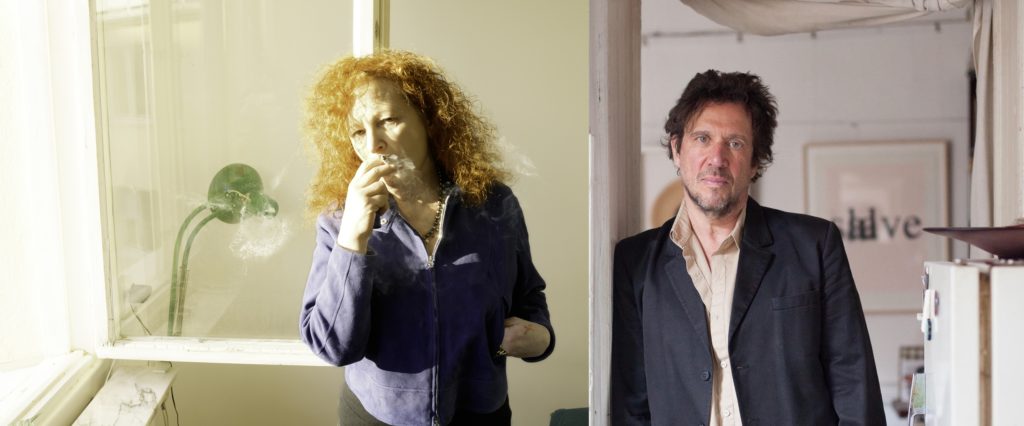
Writer and musician Richard Hell sat down for an afternoon talk with photographer and activist Nan Goldin.

Nan Goldin made her name with photographs of her friends in their habitat of downtown New York tenement apartments and nightlife clubs in the late ’70s and early ’80s. The pictures in The Ballad of Sexual Dependency (1985) represent a lost paradise to many. There’s no question, though, that looking at them is as eerily melancholy as it is inspiring, and not just because bohemian New York is gone and that we witness the era of the onset of AIDS, but because the pictures hide nothing. They proceed from a sensibility and a community that admits all: lust, loneliness, black eyes, toilets, illness, and death, along with kindness, affection, sensuality, style, exuberance, and, most of all, beauty.
In the years since Ballad, Nan has developed numerous through-lines of imagery, from hotel room interiors to pictures of children, to drag queens, to landscapes, to a recent series of fragmentary images of classical painting and sculpture at the Louvre juxtaposed in echoing tableaux with existing pictures of her friends. All these are as lush and point-blank as the images that first made her famous.
Also, since the 1980s, Goldin has been politically active and organized in opposition to AIDS. Recently she’s embarked on a new social mission, this one stemming from the first-person calamity of her own recent addiction to prescribed opioids. In 2017, she founded PAIN (Prescription Addiction Intervention Now) to combat the epidemic and to call to task the billionaires who have promoted the drugs’ over-prescription in order to profit from it.
Goldin now lives in an apartment comprising the top floor of a mansion in Clinton Hill, Brooklyn. It’s sunny and airy and large. She and I have been acquainted for 30-some years, though I don’t know her well. We found we have a lot in common, though, and we had a sweet afternoon.
NAN GOLDIN: I’m not taking pictures anymore. I’m not interested so much.
RICHARD HELL: Really?
NG: Yeah. This [advocating for action and reform in the face of the opioid crisis] has become my work and I’m painting. I’m trying to paint. That’s what I care about.
RH: I find my attitude toward my work changing. I might never write another book. It’s quite possible. I always thought of painting, too.
NG: It’s amazing.
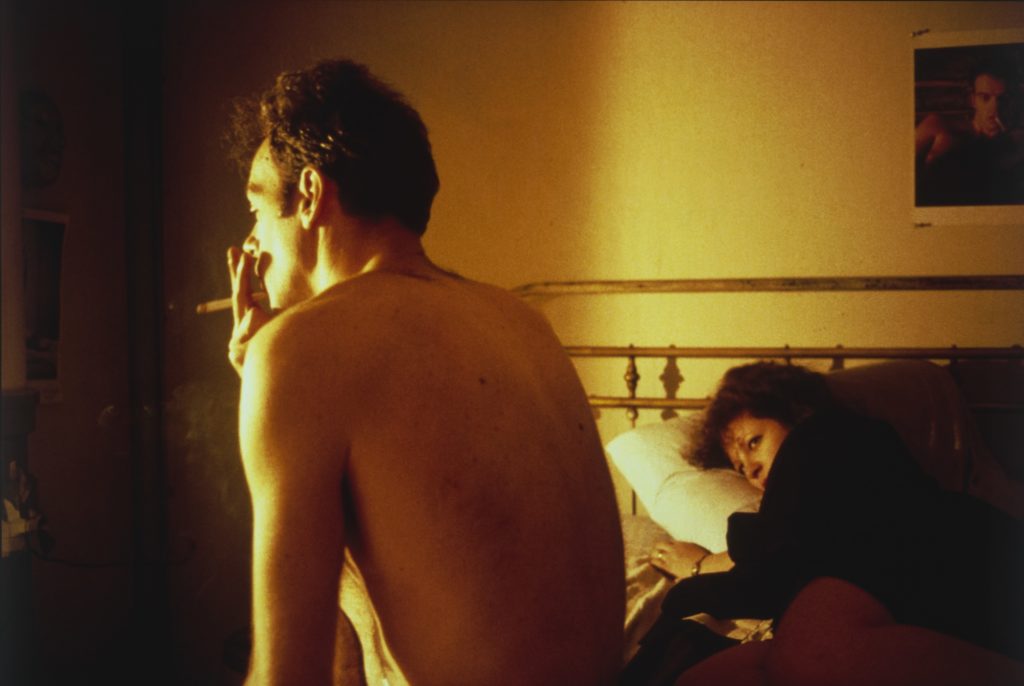
Nan Goldin, Nan and Brian in Bed, New York City. 1983. The Museum of Modern Art, New York. Acquired through the generosity of Jon L. Stryker. © 2016 Nan Goldin.
RH: I’ve always thought when I got old I would paint. The thing about painting—I think you can be senile and still paint. You can’t write a book. But you can paint. De Kooning did. I like his senile paintings.
NG: But with painting it’s tactile. And I’ve never been able to touch my photographs and that’s been a point of frustration all my life. My photographs do tend to have fingerprints on them. But it’s not a medium you can touch. It’s not a medium you handle. And even more now when it goes straight from the digital camera to a digital file.
RH: Are you using digital?
NG: Sometimes—for jobs, yeah. I like it because you get instant gratification. It’s like a Polaroid.
RH: Sure. Sure. I was wondering because I know that you didn’t have any training as a photographer—
NG: No. Only color printing I learned.
RH: At what point?
NG: I went to art school with David [Armstrong] and Philip-Lorca diCorcia and Jack Pierson and all these other madmen. And we just had fun. It was a social four years.
RH: But the thing about your pictures is that they have—one of the things about your pictures—is that they have a really distinctive color feel to them. They have this glow about them. They can be lurid colors, but at the same time, they feel golden.
NG: Yes.
RH: They have this golden feel to them.
NG: Yes, all my skin is golden. All of it. You hit it. All of my skin is golden. All of the skin in my photographs. I don’t mean my own, unfortunately. But when people print for me it’s always “add gold.” Always.
RH: So what I was wondering: Without having training, how is it that your pictures are so immediately identifiable for the way that the color feels as it does? Like even this picture of mine [on my phone—the hotel room shot of hers I have hanging at home], there’s no skin in it. It’s a hotel room and it’s golden. It glows.
NG: You get it, man. It’s heavy saturation. I see really brilliant colors. That’s how I see. I don’t see pale. Maybe I do now. But I never saw pale, washed-out colors.
RH: But how do you put that into your photographs? Does it have to do with printing techniques?
NG: No.
RH: Where does it come from?
NG: Maybe it comes from like shooting a little dark and letting things move. But that wasn’t intentional.
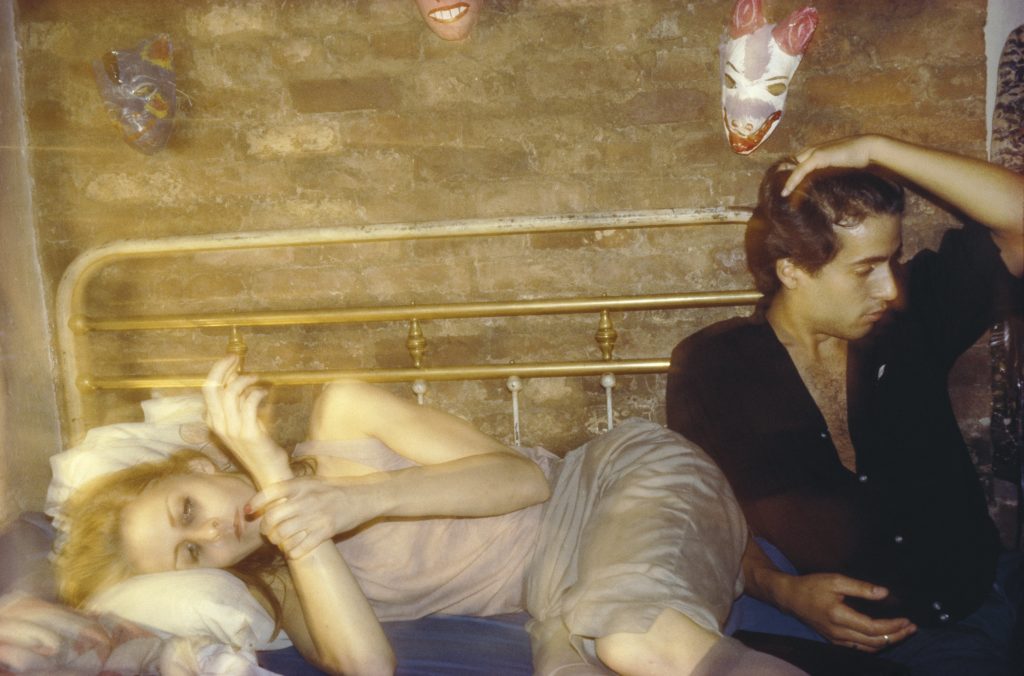
Nan Goldin, Greer and Robert on my bed, NYC (1982). Courtesy of the artist.
RH: I have noticed a blurring of things. Like the one—
NG: —of Greer Lankton.
RH: Yeah.
NG: Yeah.
RH: That looks like a Schiele or something. Where she’s lying like this, angular—
NG: And then something’s coming out of it. Sometimes there’s things coming out of people.
RH: Right, right, right. Yeah. Do people always talk about that Greer picture?
NG: They did in the ’80s. They don’t anymore. But I love that picture.
NG: People say they need drugs to create, what do you think?
RH: My experience is that when you’re using, you need drugs to do anything. So, yeah, it makes creativity possible, just as it makes walking down the street possible.
NG: I never heard it put that way. That’s great. That helps me a lot.
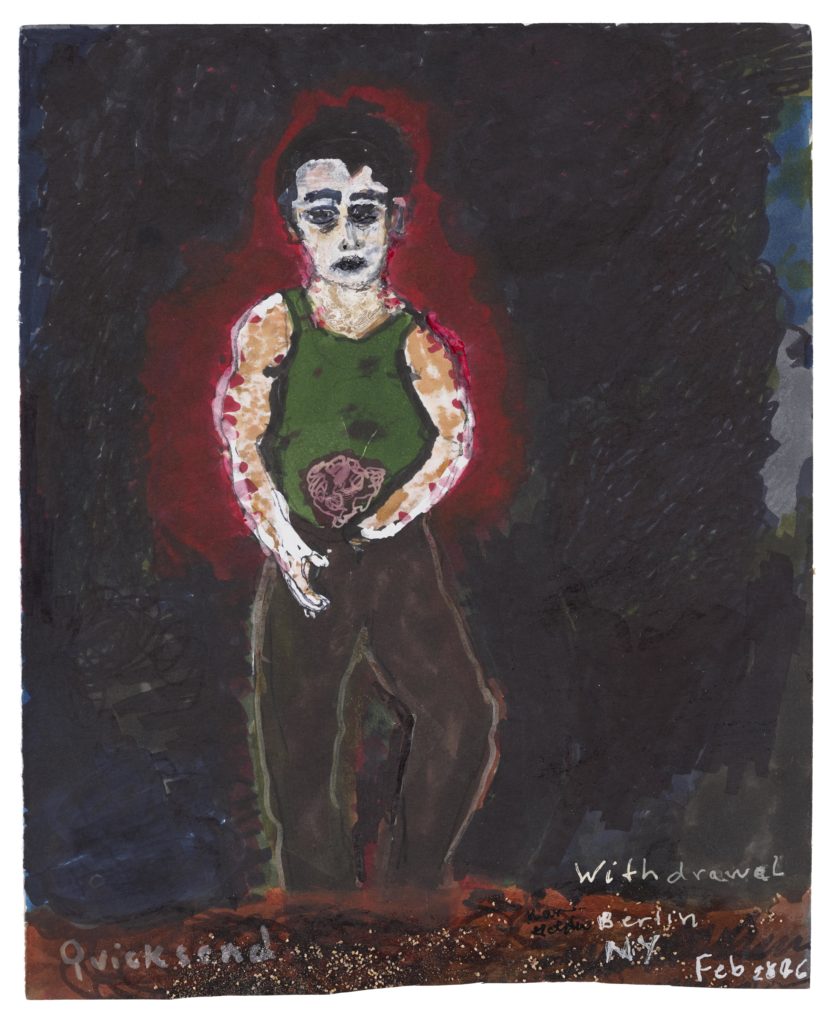
Nan Goldin, Withdrawl / Quicksand, Berlin, NY (2016). Courtesy of the artist.
RH: [Laughs] But then after years of not using, of not having any addiction, you look back and you realize how erratic you were in the periods you were using. It’s a syndrome in writing. I’ve noticed a lot of addicted writers in history—Coleridge, De Quincy, even Jim [Carroll]… They’re always having a million projects they think of that they don’t carry out. They produce a thousand fragments rather than completed works. They’re complacent because everything’s fine once they’re high. I mean, even Burroughs—
NG: The king of—
RH: —one of the rare examples of a user who actually produced a lot of full-scale completed works, though he was addicted his entire life. People always talked about him as if he quit using drugs in the ’80s or something…
NG: He went on methadone.
RH: He went on methadone and methadone is a synthetic opiate and an addiction that changes the way you feel and behave and perceive things.
NG: Yeah.
He found a way to produce work, an aesthetic that let him take advantage of the fact that he only wrote fragments. He just strung the fragments together and called it a novel! Or else cut up newspapers and old French poetry and pasted those in…[both laugh]
NG: Perfect. That’s true. But he became the poster child for heroin. So many people got high.
RH: And Lou Reed too.
NG: Unfortunately, from the age of 13, I was in a very odd, very weird, very lonely situation. And I discovered Interview and Lou Reed and the banana album. And my aspiration as a teenager was to be a junkie. So I had no denial my whole life because I had wanted to be a junkie. I mean, I didn’t start shooting dope till I was like 18. And I was completely sober all those years. I lived in a hippie commune. I went to a hippie free school. Everyone smoked. Everyone tripped. Everyone drank. And I just didn’t.
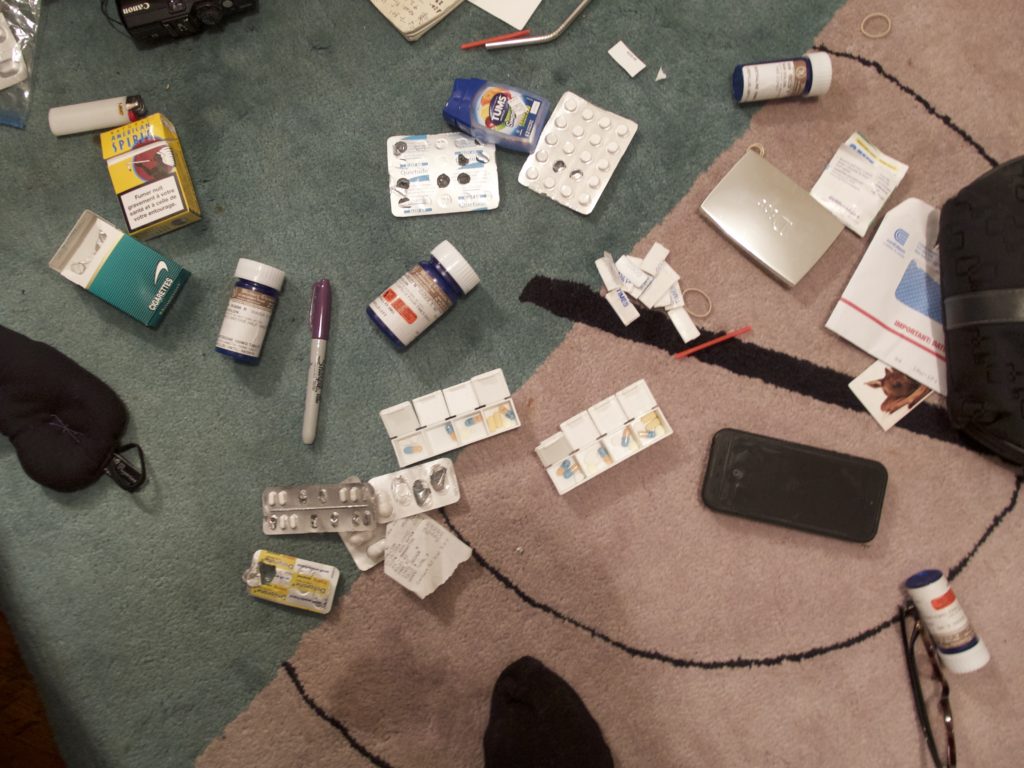
Nan Goldin, Drugs on the Rug, New York City, 2016 (2016). Courtesy of the artist.
RH: Right. Yeah, well, I was a late bloomer too. I didn’t use until I was maybe 24.
NG: And I gave up dope when I was 19 because I discovered Quaaludes.
RH: Really?
NG: And I lived on Quaaludes for years. I was a pill freak. I was always high and I snorted dope for many, many years. But I never shot. So snorting keeps you on a different level than shooting I guess. I mean, I would still get sick.
RH: Because it’s so often that people delude themselves that they’re not really junkies if they only snort…
NG: Oh, no—I feel bad that I didn’t shoot.
RH: Oh, okay. [Hell laughs]
NG: It’s the other way around. To me, injecting’s the badge of honor.
RH:Well, I mean, that’s a typical thing among junkies in general is that you’re not really using a drug unless you shoot it.
NG: I mean, I just came off 20 pills a day.
RH:Phew.
NG: And I was snorting it.
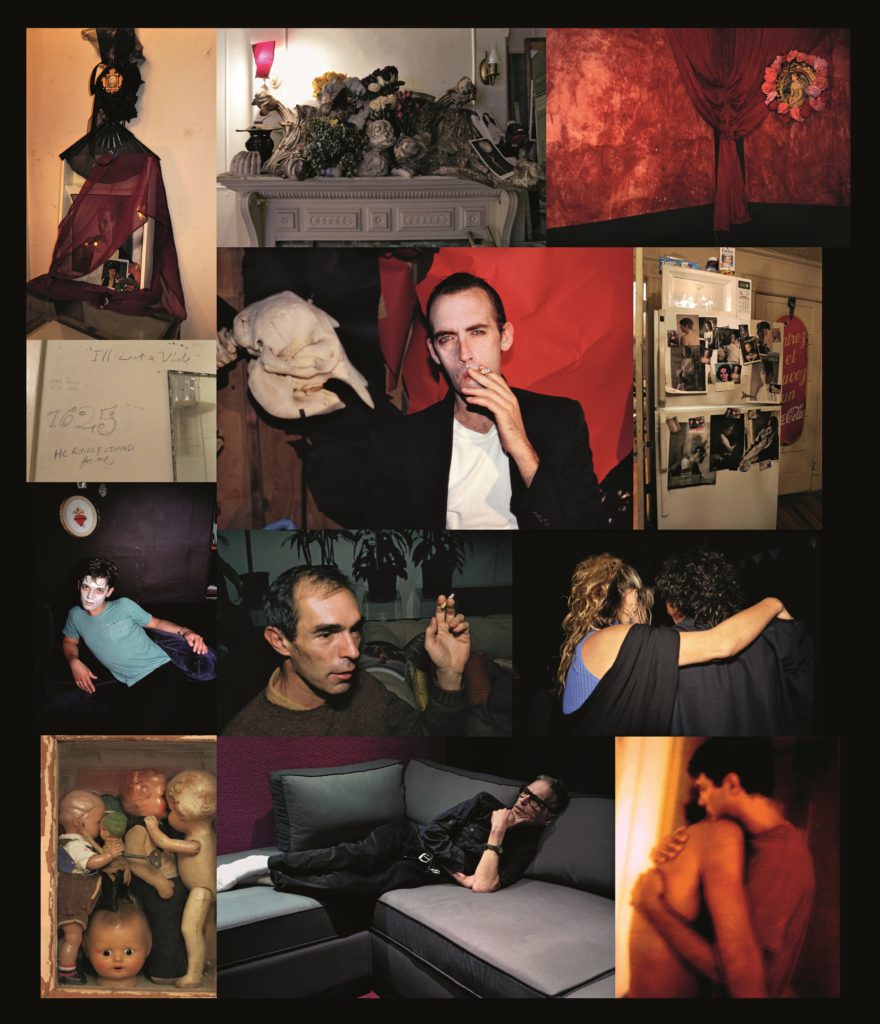
Nan Goldin, Missing, 1977–2014 (2015). Courtesy of the artist.
RH: I was recently looking at this catalogue of the West Coast artist Wallace Berman’s work, a kind of monograph about him and his circle—a genuine out-of-society collection of artists and people who rejected convention.
NG: But do you feel like there was a community like that in New York in the ’70s and ’80s?
RH: Well, the people discussed in the catalogue made me think of our circles and the people in your photos from then—Cookie Mueller, David Wojnarowicz, Rene Ricard… And even the Factory. The thing that kept striking me looking at that catalogue recently is how many of them died. And this was before AIDS. When you talk about Wallace Berman, they died from overdoses, from crime, suicide. The fatality rate seemed really high.
NG: But maybe it’s because if you’re living outside of society, you don’t have access to the economy. I just thought of that. How do you support yourself? I mean, you say crime. How do you support yourself? You know, if you’ve got a habit, crime is even more of an option. But frankly, living outside society you’re not part of the economic structure.
RH: Right.
NG: So making money is like a little harder, you know, a few steps harder.
RH: Yeah. And you’re also just generally ostracized. It makes everything harder.
NG: Well, you know what I think about that is it’s okay to be ostracized. I was always—I mean, not now; I’m advocating for the shame to be lifted on addiction and people to find communities. But at that time, I never minded being isolated from normal society. I didn’t want to be part of that. It never bothered me. Because the values of our community weren’t the same values and that was the value system I truly believed in. So I never regretted not being accepted.
RH: I think for me that it’s just confusing. Because that, the milieu, the way of life and the values of the circles that we’re talking about, it always comes with sadness. There’s this really beautiful part to it and there’s a really sad part to it. And it’s just hard for me to—there’s a way in which you think if something is sad, somebody must be—if something is consistently sad, there must be some error going on.
NG: What do you see as sad about it for yourself?
RH: All the fucking suffering, betrayal, early death, suicide, drug addiction…
NG: But it goes back to this belief by this man in Vancouver who I worship named Gabor Maté, that addiction comes from pain. So if there’s a sadness, then addiction comes with it, right? And then that leads to death. So, don’t you think there’s some connection between pain and addiction?
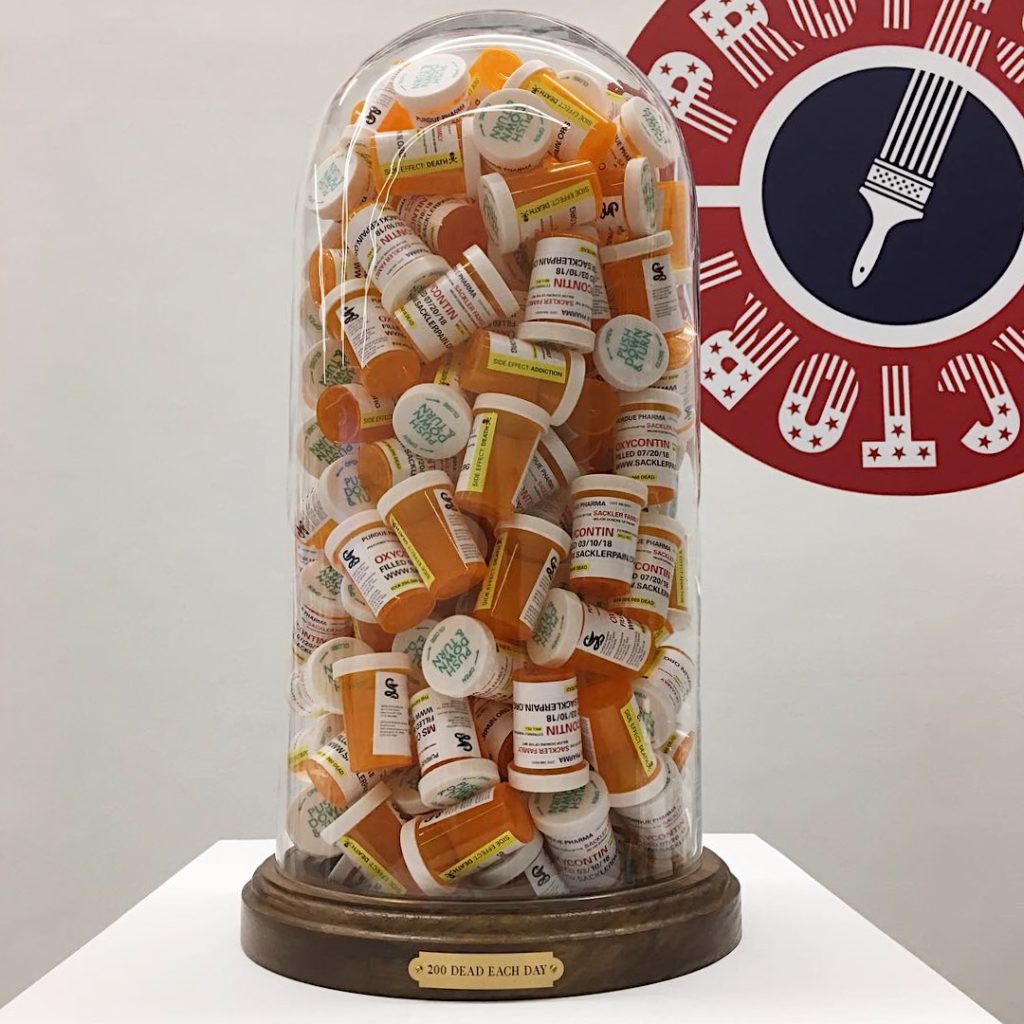
Bell jar with bottles, 200 dead a day, P.A.I.N., (2018). Courtesy of the artist.
RH: Sure. So maybe that’s the thing that the people have in common is that they’re dealing with pain?
NG: No, I don’t say that was exclusively ours by any means. I just think, you know, there’s a lot of other things. I think junkies live closer to the bone. Like we don’t have as much protection as other people. It’s like a skin. I feel like there’s a skin I’m missing. I definitely think for me that’s part of drugs and also part of what makes art people special. I mean, David Wojnarowicz, Peter Hujar, Cookie; I mean, Cookie didn’t seem to be suffering but David—
RH: No, she didn’t. That was something weird.
NG: I know. What was wrong with her? Why wasn’t she suffering?
RH: Yeah, I don’t know. For me, I’ve never understood how to live.
NG: I understand that.
RH: It’s just about I’m always looking for some kind of—it’s not a formula, some kind of signal about how to decide to behave.
NG: In the world?
RH: It just eludes me. Every day I have to start all over again figuring out how to decide what to do with myself. It’s just a failure of mine. And I look at the decisions I’ve made and I don’t even—
NG: But you have your work.
RH: But just like you said, you don’t want to take pictures anymore. And I figure for me it’s like a consequence of aging. I don’t believe in art as much as I once did. It’s all I have. It’s all I have to believe in.
NG: Me too.
RC: But it doesn’t work as well as it once did. Everything is just a pastime.
NG: I’m not sure about that. Because what I do now is I go back into my archive. I have thousands of pictures. Some I never even saw because I was too fucked up to look at them. So I have thousands of pictures. So that’s where I go to put out work now. …But I don’t know how to navigate this world at all. But I don’t know—I don’t know, what is the aim?
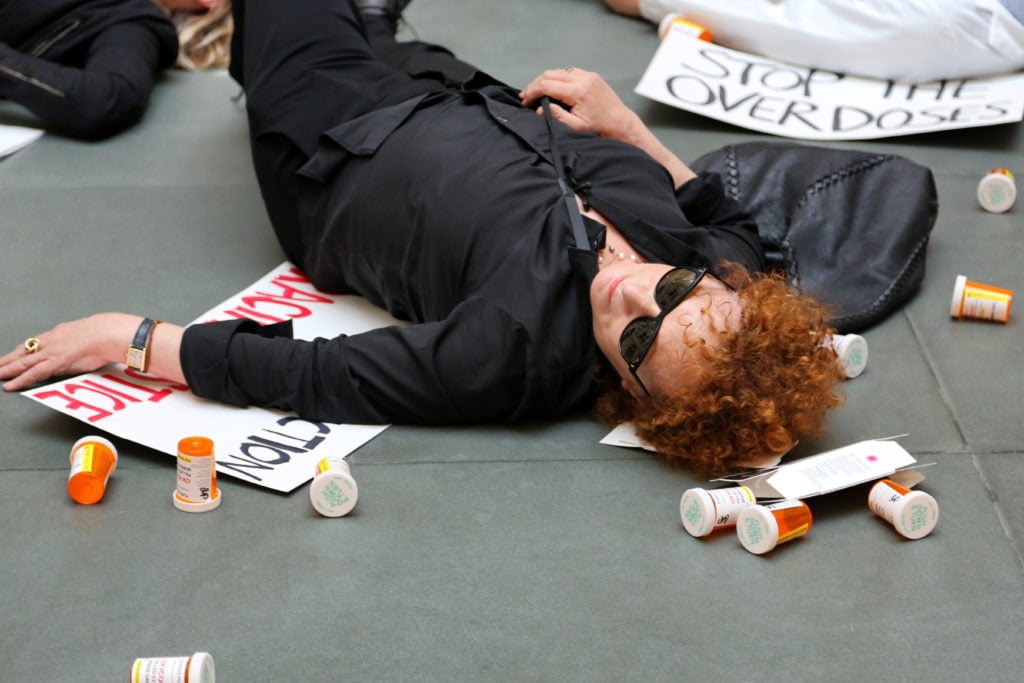
Nan Goldin staging a ‘die-in’ at the Harvard Art Museums. Photo: TW Collins.
RH: Regarding the opioid crisis, I blame the doctors a lot, as much as the Sacklers.
NG: The doctors were trained. The Sacklers and the other pharmaceutical giants took them on jaunts, bought them things. And they taught the doctors their line of misinformation and the doctors were rewarded.
RH: Who is it that’s promoting opioid pain clinics in hospitals—the Sacklers?
NG: The pharmaceutical companies. It’s not just the Sacklers—another five or 10 really evil bastards. It’s just that the Sacklers is a single family and they’ve been doing this since—
RH: They’ve also done all this art-world philanthropy, all the big contributions to the museums, like the Met and its Sackler wing.
NG: It’s a good way to wash your reputation.
RH: Right.
NG: I guess after I got clean this time—I’m only a year clean—I wanted to address something bigger than me and I wanted to push back against how fucked up the world is right now. I mean, seriously problematic to say the least, like we’re in this shit. I mean, we’re in trouble. So I decided that the thing I could push back on is what I know and that’s drugs. And I had just come out of this huge habit, where I was basically in my room here and in Europe for four years and I didn’t leave my room. I didn’t go outside except to go to the airport and then I went into my bedroom in Paris. Because I only used with my dealer and a few other people, so I wasn’t aware about the crisis. Because I really didn’t read the news, didn’t leave the house. And then when I got clean, I decided I needed to do something. And then I started this. What happened is the New Yorker article, which started the conversation in November, last year, called “The Empire Of Pain”—about the Sackler family. And there was also a portfolio of photos in the same issue of people OD’ing in Ohio. And next to the portfolio this woman wrote an article and she said: Where are the activists, like Act Up? And that’s when I decided I wanted to do something on the ground. So I have a group and we meet here once a week.
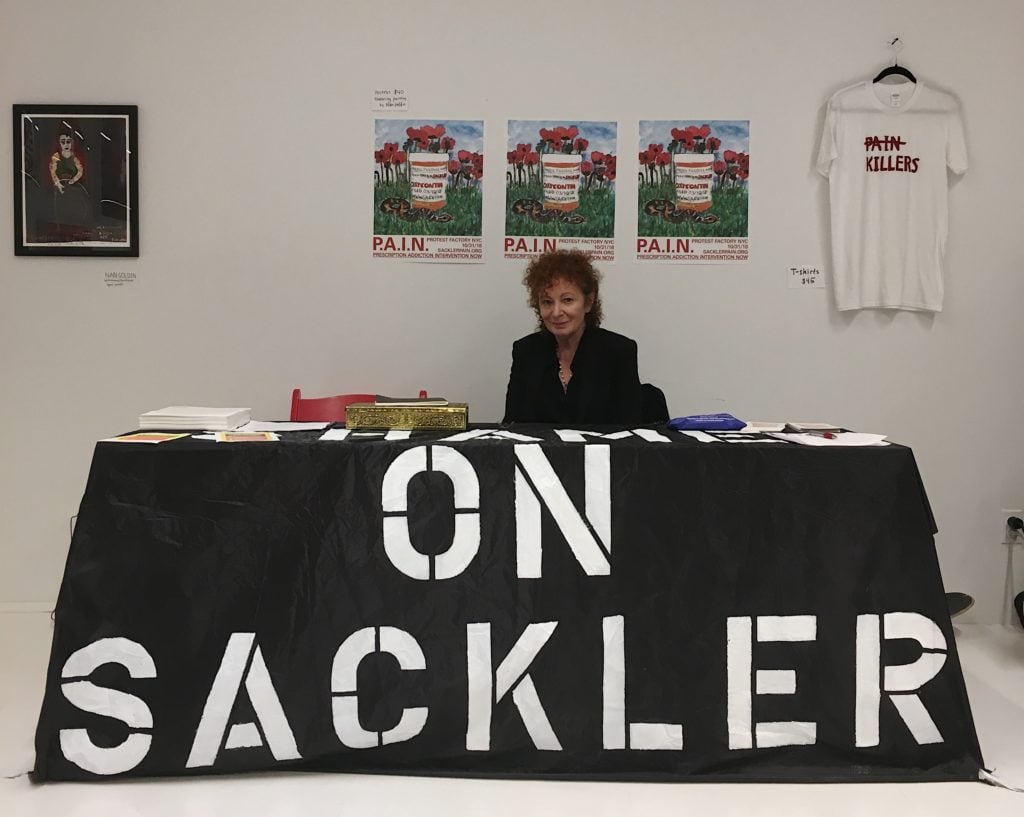
Nan Goldin at the P.A.I.N. table, at the Protest Factory, Downtown for Democracy, at Deitch Projects, 2018. Photo: Stan Narten.
RH: But what is it that you want to achieve?
NG: We want them to put money into treatment.
RH: Hmm. So what kind of progress are you making?
NG: None. Not yet. But the world’s listening now at least and that’s a big deal. But the drug war is bigger than any of us. And it’s not about to stop because it’s like the second biggest business in the world after weapons.
RH: What do you think inclines a person to use opioids? What Burroughs said was that, basically, it was access. If it’s there, a person will use it. It’s natural to want a painkiller.
NG: No, not necessarily.
RH: Which is pretty close to what you’re saying, that doctors are providing it, introducing it into everyone’s environment.
NG: I think also in our crowd everyone was using. It was kind of a rite of passage, right?
RH: A rite of passage is an accurate way to put it, since many people ended up passing. I know more people who have died directly or indirectly from drug use than from AIDS, for instance, myself.
NG: I lost many more people to AIDS.
RH: Of course, sometimes it was the drug use that transmitted AIDS, through injection. But then so another part of this mission is advocating a particular kind of treatment?
NG: We’re advocating for Narcan, the drug that reverses overdose. It should be on every corner and in every home. We are advocating for Harm Reduction—needle exchange and Safe Consumption Sites, which allow people to use in safety and should be set up in every community. A pilot program has been planned in various sites in New York, but the governor has not signed off yet. We intend to put pressure. We are also advocating for MAT, Medication Assisted Treatment. This includes Buprenorphine and Methadone. I think MAT is most effective with peer counseling and group therapy. We visited one group called Groups—not the best name I have ever heard—which is using MAT and group therapy in clinics all over America, especially in rural areas. Community is essential to stay sober, addiction is very tied to loneliness. The big thing is to try to raise awareness and cut through this fucking shame of addiction. That’s the big, big, big one.
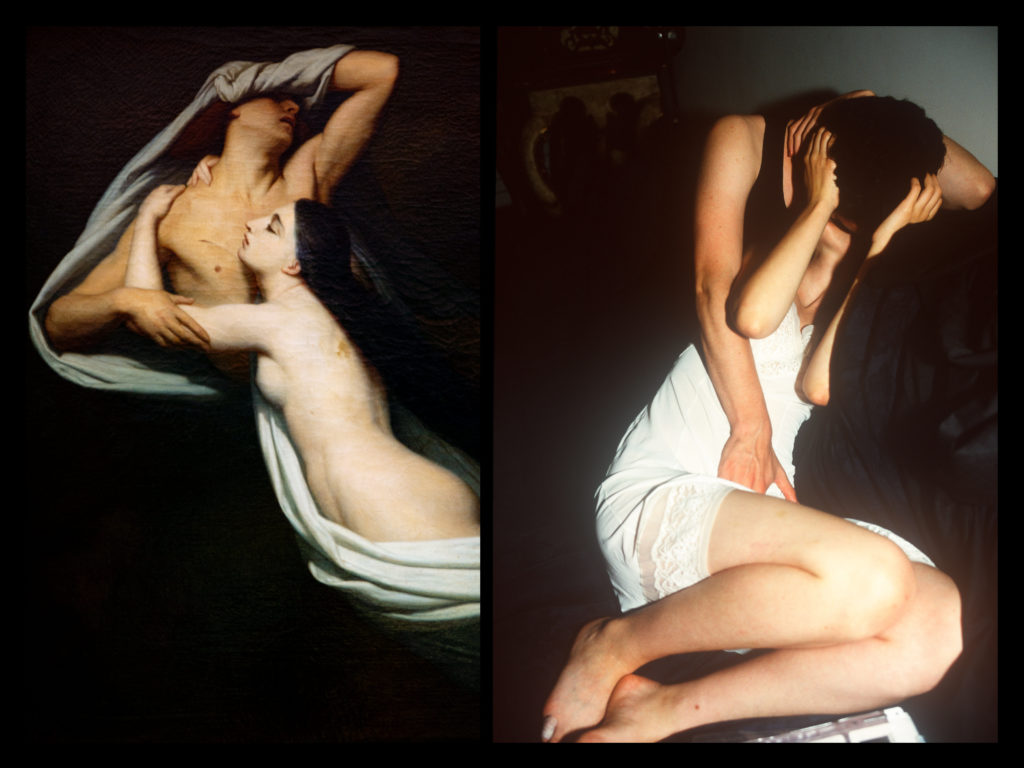
Nan Goldin, Swan-like embrace, Paris (2010). Courtesy of the artist.
RH: When people have asked about what I did as a musician—what I wanted to do differently than was being done in rock and roll when I started in a band—I realize and I tell them that what I wanted to do was bring real life back to rock and roll. And when I was preparing to see you, doing research, I saw that you said the same thing about photography.
NG: Yeah, exactly.
RH: Because we felt like we had been deceived our whole lives about what reality was.
NG: There was no record—no record.
RH: It’s being swept under the rug. And part of what real life is—a major part—is suffering. Life is suffering.
NG: Exactly.
RH: I mean, that’s what the whole message of Buddhism is.
NG: Exactly. It is the message of Buddhism. It is. Are you a Buddhist?
RH: No… Life is suffering. And everybody pretends that’s not true. And then that’s the thing—that’s the resolution, right? It explains our choices and the sadness.
NG: Like if you obsess on money and power, you don’t have to watch your own suffering. If you obsess on objects and clothes or on buying things, on capitalism, you don’t have to look. It’s all about not looking—
RH: And so that’s what a lot of the poignancy is too, is that you and me and the people that we spend time with were searching for ecstasy really.
NG: Absolutely. Or at least joy.
RH: While at the same time not wanting to kid ourselves about the reality of the suffering.
NG: That’s so well put. I mean, I think I wanted to make a record of the world that I saw, the real world and not the pretty version of the real world; not a conservative version. I grew up in suburban Maryland and it was all about ‘Don’t let the neighbors know.’ I saw all the pretense and all of the revisionism of everything. So I needed to make a record that couldn’t be revised. And it can’t really, whether people want to see it or want—
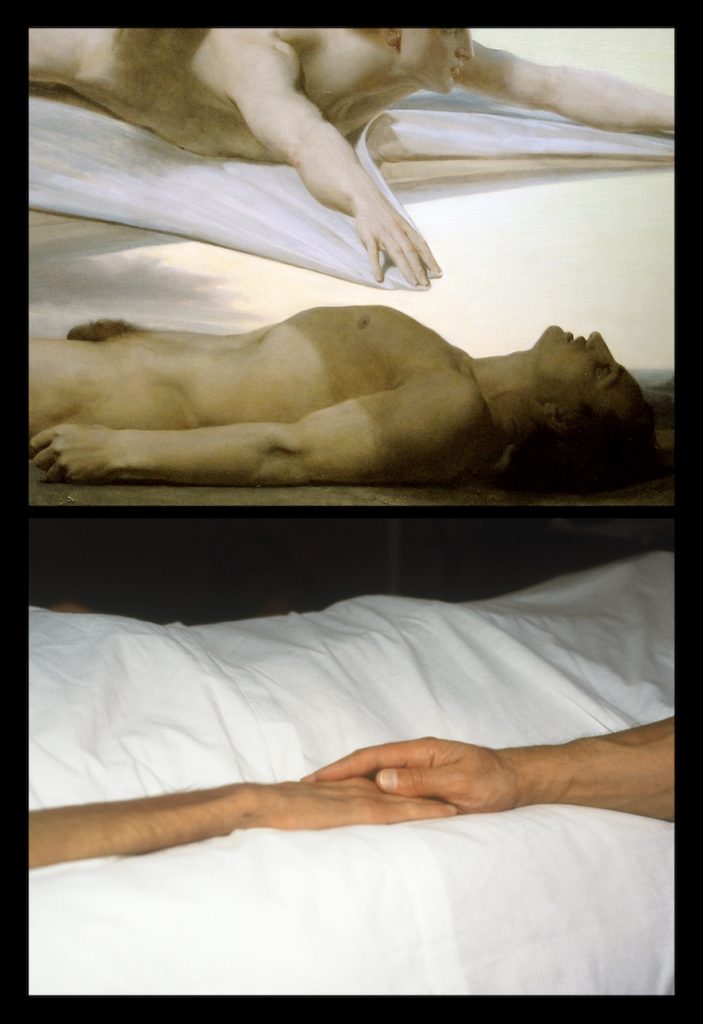
Nan Goldin, Shroud (2013). Courtesy of the artist and Marian Goodman Gallery.
RH: It was so specific and in your face.
NG: Well, you know, after my sister killed herself, that was a lot about the family structure and about denial and “That didn’t happen,” “She didn’t see that,” “You didn’t hear that,” “You don’t fit,” “You’re different from us.” And that drove my sister out and they didn’t let her back in.
RH: Right.
NG: So following that and all the denial around her suicide, I decided I had to make a record of what I saw and what I lived. Because my sister, she would have been a beatnik. She would have been with them if she had just run away to Washington instead of running away to wherever she did.
RH: So you have made that resolution that young as a teenager?
NG: Yeah. I was 11 when she died.
RH: Were you already thinking of photography as being the medium that you would use?
NG: No, no, no. I was keeping diaries. Photography started later really. That started more in the ’70s and this was in the ’60s when my sister died. Keeping diaries, like obsessive diaries. I did that for like 20 years. I stopped that too. I can’t write as fast as I did then. [Hell laughs] You know. It’s about aging too. But I ran away from home when I was like 14 and I never went back. And I lived in this commune and I went to this school that was what was called a Hippie Free School. There were no classes basically.
RH: Where was this—in Massachusetts?
NG: Yeah, around Boston in the suburbs. And I met David Armstrong there, who was my lifelong best friend. The school, because a lot of the teachers were education majors at MIT and that’s where Polaroid was invented; they were given Polaroids to give us, to photograph at the school. And I became the school photographer. So that was the first language I ever had because I was really—I didn’t speak much. So that gave me a language and that was my first ability to be part of something. So that was the beginning of photography for me.
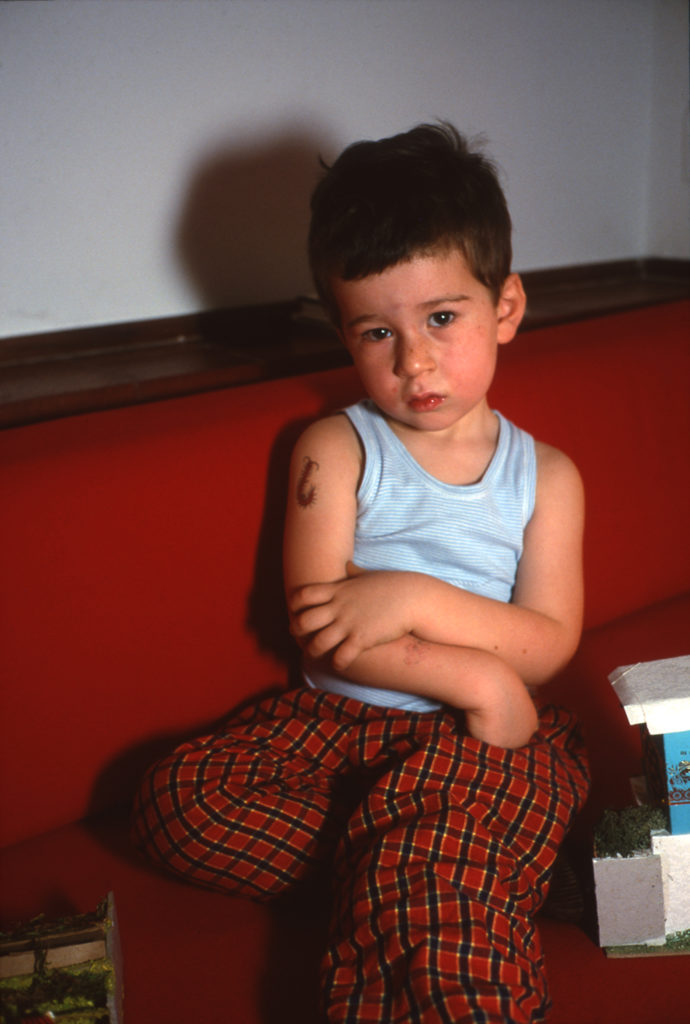
Nan Goldin, Bruno with the tattoo, Naples (1995). Courtesy of the artist.
RH: Okay, let me do a recap. I’m afraid I’m kind of blowing it. …You’re not taking photographs anymore except for fashion jobs.
NG: But I’m still putting together slideshows based on work that exists. And I still would love to do books based on images that exist.
RH: Are the slideshows still all the pictures from that period of The Ballad of Sexual Dependency?
NG: No.
RH: You’re using—
NG: Oh, no, I haven’t done a new slideshow of The Ballad for—I’ve done like 12 other slide shows.
RH: Twelve entirely different—using entirely different material?
NG: Yeah, drag queens, Bangkok, self-portraits; the big project I did at the Louvre: relationships between—You’ve seen that?
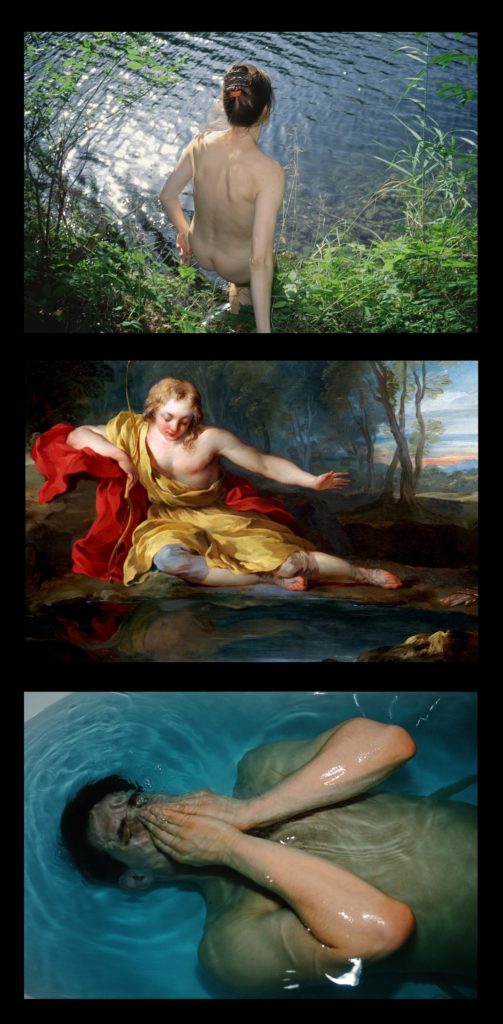
Nan Goldin, Narcissus by the Lake (2014). Courtesy of the artist and Marian Goodman Gallery.
RH: Yeah, I saw that. [The French government gave Goldin the run of the Louvre after hours to photograph paintings and details of artworks, which she then juxtaposed with her photos of her friends, where the faces and poses of them echo the Louvre artworks.]
NG: What else? There’s like 12 of them, besides The Ballad.
RH: But you’re not taking pictures?
NG: You know what I still do take pictures of is what I did for the Louvre: paintings, Renaissance paintings. Little details, not the whole picture. That’s what I love.
RH: Have you published any of those?
NG: Yeah, in my new book.
RH: What’s the new book called?
RH: Okay.
NG: Because there are pearl divers in Japan. And David and I used to say: If you take enough pictures, you’ll get a pearl. [Hell laughs] And that was the thing, I took so many pictures anybody would have gotten a good picture if they had taken as many as mine. It’s all about editing.
RH: Right.
NG: My work is all about editing.
RH: Well, this has occurred to me before, that all photography is definitely about choosing which image from all the exposed film. [looking at Nan’s book Diving For Pearls] These kid pictures are great. When I saw you were doing kids, I was like: Oh, that’s too bad. I’m going to—count me out. I don’t like kids. [Laughs]
NG: Yeah, exactly.
RH: These are terrific.
NG: Thank you. Yeah, that’s another side of kids, right? It’s another way of understanding kids. They’re not cute. My kids aren’t cute.